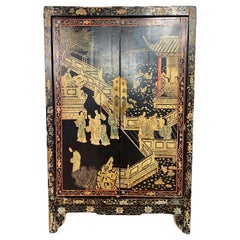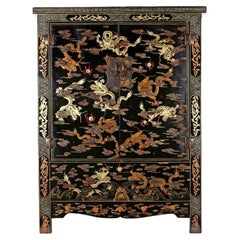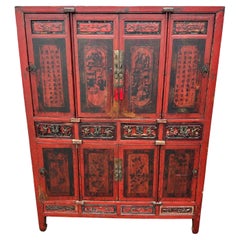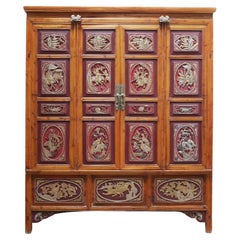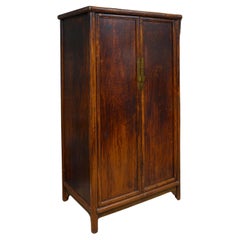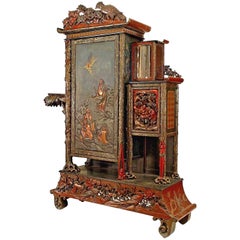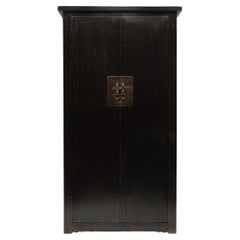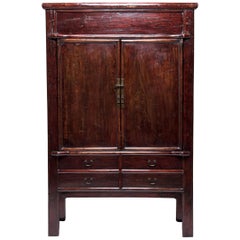Antique Chinese Wardrobes
19th Century Chinese Chinoiserie Antique Chinese Wardrobes
Wood
Early 20th Century British Antique Chinese Wardrobes
Brass
Mid-19th Century Asian Chinoiserie Antique Chinese Wardrobes
Paint
Late 19th Century Chinese Antique Chinese Wardrobes
Wood
Late 19th Century Asian Antique Chinese Wardrobes
Lacquer
Mid-19th Century Chinese Antique Chinese Wardrobes
Brass
19th Century Chinese Antique Chinese Wardrobes
Wood, Glass
Mid-18th Century Chinese Minimalist Antique Chinese Wardrobes
Elm
Early 19th Century Chinese Qing Antique Chinese Wardrobes
Elm
Early 19th Century Chinese Qing Antique Chinese Wardrobes
Iron
Early 1800s Chinese Chinese Chippendale Antique Chinese Wardrobes
Brass
Mid-18th Century Chinese Qing Antique Chinese Wardrobes
Brass
Late 19th Century Chinese Chinoiserie Antique Chinese Wardrobes
Wood
19th Century Chinese Qing Antique Chinese Wardrobes
Lacquer, Paint, Wood
Mid-19th Century Chinese Qing Antique Chinese Wardrobes
Elm
Mid-19th Century Chinese Qing Antique Chinese Wardrobes
Brass
Late 19th Century Chinese Antique Chinese Wardrobes
Wood
19th Century Chinese Antique Chinese Wardrobes
Brass
Late 19th Century Chinese Antique Chinese Wardrobes
Brass
Early 1800s French Louis XV Antique Chinese Wardrobes
Steel
Early 20th Century Qing Antique Chinese Wardrobes
Brass
Early 20th Century Chinese Qing Antique Chinese Wardrobes
Brass
1880s Chinese Qing Antique Chinese Wardrobes
Hardwood
19th Century Chinese Qing Antique Chinese Wardrobes
Wood
19th Century Chinese Qing Antique Chinese Wardrobes
Brass
Early 20th Century Chinese Qing Antique Chinese Wardrobes
Bronze
Early 20th Century Chinese Qing Antique Chinese Wardrobes
Wood
19th Century Chinese Qing Antique Chinese Wardrobes
Wood
19th Century Chinese Qing Antique Chinese Wardrobes
Brass
Early 20th Century Chinese Qing Antique Chinese Wardrobes
Brass
19th Century Chinese Qing Antique Chinese Wardrobes
Bronze
19th Century Chinese Antique Chinese Wardrobes
Elm, Lacquer
Early 20th Century Chinese Chinoiserie Antique Chinese Wardrobes
Brass, Metal
Early 20th Century Chinese Chinese Export Antique Chinese Wardrobes
Wood
Early 20th Century Chinese Chinese Export Antique Chinese Wardrobes
Wood
Late 19th Century Chinese Chinese Export Antique Chinese Wardrobes
Cypress
Early 20th Century Chinese Chinese Export Antique Chinese Wardrobes
Wood
Late 19th Century Chinese Chinese Export Antique Chinese Wardrobes
Wood
1920s Chinese Chinese Export Antique Chinese Wardrobes
Wood
Late 19th Century Unknown Chinoiserie Antique Chinese Wardrobes
Hardwood
Early 20th Century Antique Chinese Wardrobes
Wood
19th Century Chinese Neoclassical Antique Chinese Wardrobes
Mirror, Teak
Early 20th Century Chinese Ming Antique Chinese Wardrobes
Wood
19th Century Chinese Antique Chinese Wardrobes
Cedar
19th Century Chinese Antique Chinese Wardrobes
Mid-19th Century Chinese Ming Antique Chinese Wardrobes
Elm
Early 20th Century Chinese Antique Chinese Wardrobes
19th Century Chinese Antique Chinese Wardrobes
Wood
18th Century and Earlier Chinese Antique Chinese Wardrobes
19th Century Chinese Antique Chinese Wardrobes
Elm
19th Century Chinese Antique Chinese Wardrobes
18th Century and Earlier Chinese Antique Chinese Wardrobes
Early 20th Century French Antique Chinese Wardrobes
Glass, Walnut
19th Century Chinese Antique Chinese Wardrobes
19th Century Chinese Antique Chinese Wardrobes
19th Century Chinese Antique Chinese Wardrobes
Elm
19th Century Chinese Antique Chinese Wardrobes
Elm
Early 20th Century Chinese Antique Chinese Wardrobes
Elm
Early 20th Century Chinese Antique Chinese Wardrobes
Elm
Early 20th Century Chinese Antique Chinese Wardrobes
Bronze
- 1
Antique Chinese Wardrobes For Sale on 1stDibs
How Much are Antique Chinese Wardrobes?
Finding the Right Storage-case-pieces for You
Of all the vintage storage cabinets and antique case pieces that have become popular in modern interiors over the years, dressers, credenzas and cabinets have long been home staples, perfect for routine storage or protection of personal items.
In the mid-19th century, cabinetmakers would mimic styles originating in the Louis XIV, Louis XV and Louis XVI eras for their dressers, bookshelves and other structures, and, later, simpler, streamlined wood designs allowed these “case pieces” or “case goods” — any furnishing that is unupholstered and has some semblance of a storage component — to blend into the background of any interior.
Mid-century modern furniture enthusiasts will cite the tall modular wall units crafted in teak and other sought-after woods of the era by the likes of George Nelson, Poul Cadovius and Finn Juhl. For these highly customizable furnishings, designers of the day delivered an alternative to big, heavy bookcases by considering the use of space — and, in particular, walls — in new and innovative ways. Mid-century modern credenzas, which, long and low, evolved from tables that were built as early as the 14th century in Italy, typically have no legs or very short legs and have grown in popularity as an alluring storage option over time.
Although the name immediately invokes images of clothing, dressers were initially created in Europe for a much different purpose. This furnishing was initially a flat-surfaced, low-profile side table equipped with a few drawers — a common fixture used to dress and prepare meats in English kitchens throughout the Tudor period. The drawers served as perfect utensil storage. It wasn’t until the design made its way to North America that it became enlarged and equipped with enough space to hold clothing and cosmetics. The very history of case pieces is a testament to their versatility and well-earned place in any room.
In the spirit of positioning your case goods center stage, decluttering can now be design-minded.
A contemporary case piece with open shelving and painted wood details can prove functional as a storage unit as easily as it can a room divider. Alternatively, apothecary cabinets are charming case goods similar in size to early dressers or commodes but with uniquely sized shelving and (often numerous) drawers.
Whether you’re seeking a playful sideboard that features colored glass and metal details, an antique Italian hand-carved storage cabinet or a glass-door vitrine to store and show off your collectibles, there are options for you on 1stDibs.
- 1stDibs ExpertNovember 4, 2024To identify antique Chinese furniture, look carefully at its details. Chinese craftsmen often built furniture using mortise and tenon joinery, eliminating the need for nails and screws. If you see this type of hardware, your piece is likely not at least 100 years old, especially if the hardware still looks new and shiny. Since antique furniture was handmade, you will normally see slight imperfections, such as tool marks or slight variations in carvings. Pieces that appear completely uniform and pristine are less often genuine antiques.
When present, maker's marks can also be helpful. Research the marks to learn more about when the maker was active and producing pieces like yours. Alternatively, you can have a certified appraiser or experienced antique dealer evaluate your furniture for you.
Shop an assortment of antique Chinese furniture.  Lotus GallerySeptember 23, 2020
Lotus GallerySeptember 23, 2020The best way to know is to take it to an expert, such as an appraiser, reputable dealer or auction house, or museum
 PAGODA REDOctober 7, 2020
PAGODA REDOctober 7, 2020To determine the age of a Chinese furniture piece, look carefully at the joinery and finish. Natural expansion and contraction of the wood over time will cause a joint to protrude or retract, distorting a once-seamless fit. Antique lacquer finishes become crackled and worn over time. Areas of exposed wood, such as the underside of a table, the footrest of a chair, or the back of a cabinet should appear raw and dry compared to the finished surface. With use, the legs of tables and chairs become weathered near the bottom from precipitation and use.
Read More
The Ultimate Guide to Types of Tables for the Home
Whether you’re just moving in or ready to give your home a makeover, our guide will give you pointers on tables that are fitting for every room, nook and hallway.
What Exactly Is a Secretary Desk, and What Is It Used For?
The furniture equivalent of a Swiss Army knife, it's the multifunctional piece you didn't know you needed.
This Shelving System with Oxidized Brass Tubes Is Retro and Futuristic at Once
Italian studio DimoreMilano mustered great ingenuity when crafting these sculptural shelves, which are built without any screws.
28 Cheerful Home Bars, Where Everybody (Literally) Knows Your Name
Simple or sophisticated, equipped with console, cart or custom cabinetry, these stylish bar areas deserve a toast.
Ask an Interior Designer: Work-from-Home Edition
Leaping into a design project, whether it's refreshing the bedroom or redoing the whole house, can be overwhelming. Luckily, we know more than a few interior designers. You asked questions on Instagram, and now they're answering.
Collected and Eclectic, ‘Wunderkammern’ Are Back in a Big Way
Introduced nearly 500 years ago, curiosity cabinets are finding new fans among today's collectors and designers.
Meet the Incredible Woman Transforming Fallen Trees into Sleek Furniture
In the hands of New York Heartwoods cofounder Megan Offner, unwanted local trees become works of design art.
These New York Architects Love a Complicated Project
From Brooklyn townhouses to Maine campgrounds, Trattie Davies and Jonathan Toews relish a challenge, like transforming a former warehouse space into the new 1stdibs Gallery.
